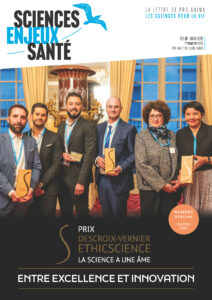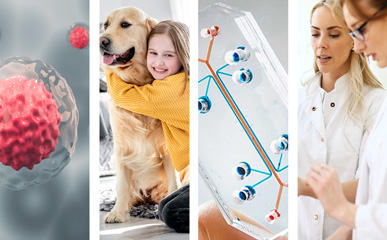
ECHA’s Strategy Statement, approach to UK chemicals regulation, catalyzing the development of NAMs in the US and more
News on non-animal methods
Feb 5-9, 2024NEWS, REPORTS & POSITION STATEMENTS
1. ECHA statement 2024 — 2028
ECHA has recently shared its Strategy Statement for 2024 – 2028. Among the different focuses of the strategy committed to a high level of protection of health and environment, alongside the promotion of green, digital, and sustainable growth, one of the priorities listed on the report is to promote the development and use of alternative methods for the assessment of hazards and risks of chemicals.
ECHA wants to : increase understanding, awareness and competence of how new approach methodologies (NAMs) can be used to regulate chemicals ; contribute actively to the EU plans/roadmap to replacing animal testing ; continue to collaborate with EU, international and academic partners on the development of alternatives to animal testing and their use for hazard and risk assessment.
Read ECHA’s Strategy Statement
2. Vision for a modern science-based approach to UK chemicals regulation
Companies that produce chemicals are required by law to ensure that their products are safe for humans and the environment. The regulations governing this in the European Union (e.g. REACH) were directly transposed into UK law upon EU-Exit.
A group of experts from UK industry and academia has developed a paper to set out the investment and commitment required to improve domestic chemical safety regulation and enable the use of cutting-edge technological and scientific developments. They suggest that embracing a more flexible, modernised and sustainable approach to UK chemicals regulation will create significant scientific, business and societal benefits, by reducing the reliance on animal-based testing methods to protect human health and the environment.
3. NIH Statement on catalyzing the development of novel alternative methods
Major leaps in science are often driven by the invention of new technologies and approaches. With the explosion of work being done in developing and using NAMs, NIH charged a working group of the Advisory Committee to the Director (ACD) to assess the challenges and opportunities for NAMs, as well as provide recommendations to the ACD for priority investments to catalyze their use and development in biomedical research.
The working group consulted with experts in the field and reviewed input from the community to deliver its report to the ACD during the Dec. 14, 2023, meeting, recommending among other things that NIH work with the community to prioritize the development and use of combinatorial NAMs, establish resources, infrastructure, and collaborations, promote effective dissemination and interconnection and invest in comprehensive training to bolster continuous advances in development and use of NAMs.
4. A three-pillar approach to driving organoid adoption in drug discovery, by Nikki Karter and Victoria Durban from Molecular Devices
Since December of 2022, when Congress passed the FDA Modernization Act, there is increasing interest in using organoids (3D, human-derived cellular models) for disease modeling and drug discovery. But to capitalize on that interest and drive the adoption of organoids, the industry needs to address several challenges. Developing and scaling up organoids in a reproducible way is difficult and labor-intensive. And getting regulators on board with data generated from organoid research is a hurdle, because the relevance and reliability of data gained using organoids are still not as well understood as animal model data are.
The latest technology advances, particularly in artificial intelligence, are helping to advance organoid scalability and reproducibility, driving wider applications and regulatory acceptance. To make the most of these advances, the industry should embrace a three-pillar strategy : 1. Mapping organoids to complex human biology ; 2. Improving scalability and reproducibility ; and 3. Building acceptance for organoids among regulators
INDUSTRY, BIOTECH & PARTNERSHIPS
5. 2.3 millions euros grant by Eurostars for the automated production of 3D cell-based assays
Readily3D, CelVivo, Bioneer, SDU and EPFL will merge their expertise to develop a platform for the automated production of 3D cell-based assays..This project has received funding from the Eurostars‑3 joint programme with co-funding from the European Union’s Horizon Europe research and innovation programme.
Eurostars is part of the European Partnership on Innovative SMEs. The partnership is co-funded by the European Union through Horizon Europe. The Swiss partners also acknowledge co-funding by Innosuisse, the Swiss Innovation Agency. In addition, the Danish partners acknowledge co-funding by Innovation Fund Denmark (IFD).
6. Axol Bioscience and NETRI sign product supply agreement
Axol Bioscience announces the signing of a product supply agreement with NETRI to supply Organs-on-chip (OoC) kits including devices and human iPSCs for pre-clinical neuroscience research, cosmetics and drug discovery. This exciting agreement paves the way for future co-development work between NETRI, an OoC provider and Axol Bioscience, a leading supplier of iPSC-derived cells for advanced in vitro platforms.
With this agreement, they continue the ongoing progress towards building new models of NETRI’s high-throughput NeuroFluidics devices powered by functional axoCellsTM that enable the pharmaceutical and dermo-cosmetics industries with access to human-relevant in vitro OoC models.
7. Insilico Medicine and University of Toronto Partner to Develop AI Drugs for ‘Undruggable’ Cancer Targets
University of Toronto’s professor Igor Stagljar entered into a partnership with Insilico Medicine, an AI-driven drug discovery company, to target “undruggable” cancer targets – those which conventional therapeutics have been unable to address.
Under this collaboration, two assays are being utilized : a live-cell drug screening platform (MaMTH-DS) for identifying and monitoring Protein-Protein Interactions (PPIs), and SIMPL assay, that uses a split intein (a type of protein with unique properties that occurs naturally in many cells) as a sensor for PPI detection in any human protein in any cell line.
With live cell assays, researchers can quickly determine the efficacy of AI-designed molecules in inhibiting specific protein targets, potentially reducing the drug validation process from 4 – 5 years to just months.
SCIENTIFIC DISCOVERIES & PUBLICATIONS
8. An AI discovers the first new antibiotics in 60 years
The discovery of novel structural classes of antibiotics is urgently needed to address the ongoing antibiotic resistance crisis. Deep learning approaches have aided in exploring chemical spaces but typically use black box models and do not provide chemical insights.
A recent study empirically tested 283 compounds and found that compounds exhibiting antibiotic activity against Staphylococcus aureus were enriched in putative structural classes arising from rationales. This new approach enables the deep learning-guided discovery of structural classes of antibiotics and demonstrates that machine learning models in drug discovery can be explainable, providing insights into the chemical substructures that underlie selective antibiotic activity.
9. The case of the missing mouse — developing cystic fibrosis drugs without using animals
Creating and developing new drugs can take decades, costs millions of dollars, requires untold human effort and usually, takes thousands of animal lives while extensive preclinical testing in animals is still no guarantee that drugs will be safe and/or effective.
This new paper describes recent advances in drug development where non-animal approaches have been used, to explore how and where these could be applied more widely to revolutionize the drug development pipeline and accelerate the creation of safe and effective medicines. As one case study, they look at the development of a drug for the fatal genetic condition, cystic fibrosis. They also take a closer look at where drug development could be accelerated by focusing on innovative, human biology-based testing methods. Finally, they put forward recommendations, targeting all stakeholders, including the public, that will be needed to put this into practice and enable drug development to become more efficient — focusing on human-biology based testing and cutting out the middle-mouse.


